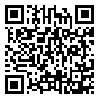Volume 80, Issue 4 (July 2022)
Tehran Univ Med J 2022, 80(4): 331-336 |
Back to browse issues page
Download citation:
BibTeX | RIS | EndNote | Medlars | ProCite | Reference Manager | RefWorks
Send citation to:



BibTeX | RIS | EndNote | Medlars | ProCite | Reference Manager | RefWorks
Send citation to:
Khademi M, Masaeli M, Azarmnia M, Shahabian M, Karamnejad M, Azimi Aval M R et al . Comparing the diagnostic accuracy of bedside ultrasound with wound exploration in diagnosis of nerve and tendon injuries in upper extremities: a brief report. Tehran Univ Med J 2022; 80 (4) :331-336
URL: http://tumj.tums.ac.ir/article-1-11816-en.html
URL: http://tumj.tums.ac.ir/article-1-11816-en.html
Marzieh Khademi * 
 1, Maryam Masaeli2
1, Maryam Masaeli2 
 , Mehdi Azarmnia2
, Mehdi Azarmnia2 
 , Masoud Shahabian2
, Masoud Shahabian2 
 , Maziar Karamnejad3
, Maziar Karamnejad3 
 , Mohammad Reza Azimi Aval4
, Mohammad Reza Azimi Aval4 
 , Azadeh Asghari Birbaneh5
, Azadeh Asghari Birbaneh5 


 1, Maryam Masaeli2
1, Maryam Masaeli2 
 , Mehdi Azarmnia2
, Mehdi Azarmnia2 
 , Masoud Shahabian2
, Masoud Shahabian2 
 , Maziar Karamnejad3
, Maziar Karamnejad3 
 , Mohammad Reza Azimi Aval4
, Mohammad Reza Azimi Aval4 
 , Azadeh Asghari Birbaneh5
, Azadeh Asghari Birbaneh5 

1- Department of Emergency Medicine, School of Medicine, Aja University of Medical Sciences, Tehran, Iran. , Khademimarzie@yahoo.com
2- Department of Emergency Medicine, School of Medicine, Aja University of Medical Sciences, Tehran, Iran.
3- Department of Surgery, School of Medicine, Dezful University of Medical Sciences, Dezful, Iran.
4- School of Medicine School, Aja University of Medical Sciences, Tehran, Iran.
5- Department of Pathology, Hjoerring, Regional Hospital of Northern Jutland, Denmark.
2- Department of Emergency Medicine, School of Medicine, Aja University of Medical Sciences, Tehran, Iran.
3- Department of Surgery, School of Medicine, Dezful University of Medical Sciences, Dezful, Iran.
4- School of Medicine School, Aja University of Medical Sciences, Tehran, Iran.
5- Department of Pathology, Hjoerring, Regional Hospital of Northern Jutland, Denmark.
Abstract: (2619 Views)
Background: Trauma is one of the most common causes of death in all ages. Considering the prevalence of trauma in the general population, and its costs and complications, it is important to use aiding tools to accelerate the diagnosis in order to act in time. The aim of this study was to evaluate the efficacy of ultrasound in diagnosing nerve and tendon injuries in the upper extremities.
Methods: This study is a cross-sectional study, which was carried out at the emergency department of the Besat Hospital, Tehran from march 2018 to march 2019. The statistical population was all patients who had been referred with deep lacerations in upper extremities and had injuries in the superficial or deep compartments (nerves/ tendons). For all the patients who met the inclusion criteria, bedside sonography with 11 Mhz Linear probe was performed by the researcher and under the supervision of the radiologist. The results were compared with the results from local exploration of the wounds. Local exploration of the wounds was also done under the surgeon's supervision. After completing the sample size and data collection, SPSS software, version 22 (IBM SPSS, Armonk, NY, USA) was used for statistical analysis
Methods: This study is a cross-sectional study, which was carried out at the emergency department of the Besat Hospital, Tehran from march 2018 to march 2019. The statistical population was all patients who had been referred with deep lacerations in upper extremities and had injuries in the superficial or deep compartments (nerves/ tendons). For all the patients who met the inclusion criteria, bedside sonography with 11 Mhz Linear probe was performed by the researcher and under the supervision of the radiologist. The results were compared with the results from local exploration of the wounds. Local exploration of the wounds was also done under the surgeon's supervision. After completing the sample size and data collection, SPSS software, version 22 (IBM SPSS, Armonk, NY, USA) was used for statistical analysis
|
Results: In this study, from 144 patients with penetrating trauma in the upper extremities, 56 patients were suspected with nerve injuries and 50 patients were suspected with tendon injuries. After evaluation with an ultrasound probe, 21 out of 23 cases suspected of nerve injuries were confirmed by local exploration. Local exploration confirmed that 27 out of 28 cases were suspected of tendon injuries. The accuracy of ultrasound in the assessment of nerve damage was estimated at 99.64% and in tendon damage at 92%, and the sensitivity of ultrasound in the diagnosis of nerve damage was 91.30% and in the diagnosis of tendon damage was 96.42%.
Conclusion: By the results of this research it can be concluded, that ultrasound leads to a faster diagnosis. It provides a wider field of view, can reduce possible secondary injuries and increases the accuracy of the diagnosis. |
Type of Study: Brief Report |
Send email to the article author
| Rights and permissions | |
 |
This work is licensed under a Creative Commons Attribution-NonCommercial 4.0 International License. |



